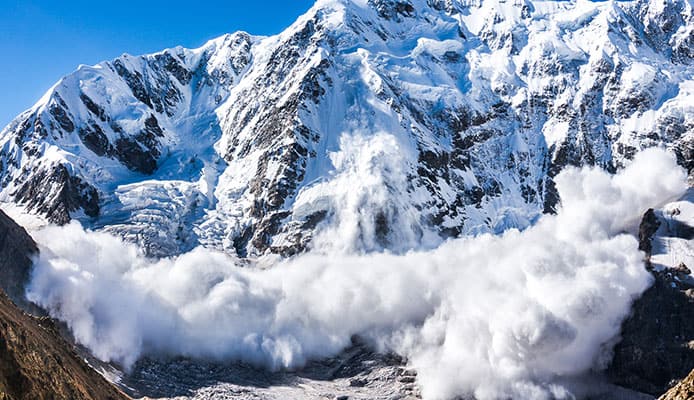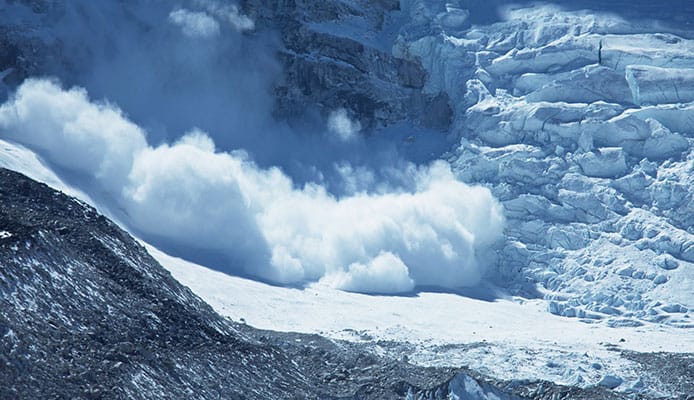
Winter sports are fun and can make even the coldest of days warm. There is nothing more thrilling than snowboarding or skiing your way down an icy slope on a sunny winter afternoon.
While pursuing your favorite mountain sport at this time of the year can be exciting, it can be hazardous too, as there are high chances of triggering an avalanche.
In recent years, there have been so many cases of winter hikers, mountaineers, snowmobilers, and backcountry skiers who have lost their lives to avalanches. That’s why it is crucial for every winter sports enthusiast, and anyone else looking to venture into cold weather hiking, to know the snow conditions of the trail they will be on and what to do should they experience the misfortune of an avalanche.
Here are some tips on how to survive an avalanche and stay safe in the backcountry.
Preparation
The best and easiest way to guarantee yourself avalanche survival is to avoid being swept up in an avalanche in the first place. “And how do I do that”, you may ask?
Education
They say “Knowledge is power” and taking some time to learn more about avalanches can help you prepare and increase your likelihood of survival. Sure, you can’t completely avoid avalanches but understanding the elements that increase their occurrence can significantly minimize your risk of getting into one.
The factors that may affect the occurrence of avalanches include the angle of the slope, wind, temperature, sun, and snow conditions. The hazard level of an avalanche fluctuates as these conditions change.
Take a course on avalanche safety and survival. Most agencies providing skateboarding, snowboarding, or even ice fishing courses today will cover this in their training.
If you are traveling to an avalanche-prone area and feel like you need some brushing up on how to survive an avalanche, it would be worth enrolling in one of the avalanche courses administered by your local agency.
Gear
Just like when going for a hike, backpacking trip, or any other outdoor adventure, it is important to carry the right equipment when going out in the snow. If you want to potentially save your life and that of others, these are the pieces of gear you should stash in the day’s backpack.
· Avalanche Beacon
Some people call it an avalanche beacon or personal locator beacon. Others call it a transceiver. We call it a lifesaver. Basically, an avalanche beacon is a device used on the trail to send and receive alert tones to locate someone who is missing (in this case buried in the snow).
In normal use, the beacon will be set to “transmit” mode to send out the tone. The person searching will turn his device to “receive” mode, which will allow him to receive and hear the sent tone and as a result, he will be able to find the missing person.
· Avalanche Probes
These resemble a collapsible ski or trekking pole but a bit longer. They are usually made from carbon fiber or aluminum and their job is to locate a person buried in the snow too.
Just push down through the rubble and you will be able to pinpoint the exact position of the missing person. When used together with a beacon, an avalanche probe can significantly hasten the discovery process.
· A Shovel
On such a trip, you will need a survival shovel too. Most backcountry snowboarders and skiers carry avalanche shovels that they can use when they need to dig someone out of the snow.
If you are bringing a folding shovel. These are easily collapsible and won’t take too much space in your bag.
· Avalanche Airbag
An avalanche airbag is a device that senses when someone has been swept up in an avalanche. It is similar to a car’s airbag and will deploy automatically when you are caught up in a slide.
The airbag will nicely attach to your backpack especially if you are using a winter-specific pack. Modern winter and hiking backpacks come with the option of strapping an airbag to ensure your safety.
Once the bag inflates, you will be able to stay “floating” on the ice, rocks, and other debris, which will increase your chances of avalanche survival.
What To Do If You Get Into An Avalanche

Sometimes, despite your experience or best efforts at preparation, you will find yourself being a victim of an avalanche. If this happens, here is what to do.
1. Shout
Shout out to other people in your group to alert them. Raise your hands to send a signal so they can see you and mark where you are before you get swept away by the avalanche.
2. Check Your Gear
If you have an avalanche survival gear like an airbag, check to see it is inflated. If not, try to activate it manually.
3. Let Go Of Heavy Gear
How to survive an avalanche will partly depend on how lightweight you are. So if possible, let go of any heavy equipment like the snowboard or skiboard but keep your backpack especially if it’s where you have attached your airbag. Hold on to your beacon, shovel, or probe too – you may need these if you end up under the snow.
4. Try To Remain On Top
If an avalanche sweeps you off your feet, try as much as you can to stay close to its surface. Whether to try a swimming motion or not has been debated for years, but if there is any way you can use your legs and arms to increase your surface area, you will be able to stay on the surface.
By doing this, you will end up either on the avalanche’s surface when it sweeps out or near the surface, and either of these places will increase your chances of survival. Just make sure you are keeping your mouth closed when you breathe to keep snow from collecting in your mouth.
5. Trap Some Air
Even when the slide slows to a stop, continue fighting to remain on top because if you don’t, you’ll be buried alive. Use one of your hands to trap some air around your mouth and nose by pushing the ice away from your face and extracting some air from the ice pack.
When the avalanche comes to a halt, you may not be able to make any movements because the weight of the ice will have frozen you in place. That’s why it is important to create yourself an air pocket so you don’t end up with a snow mask around your mouth and nose.
Ice masks are the number one cause of death for those who get swept up in an avalanche. They block your oxygen source, causing unconsciousness and suffocation.
You might also like: Top Women’s Ice Skates
6. Raise Your Hand Or Pole
If you have successfully made your air pocket and are still able to make some movements, thrust your other arm upward in the direction of the avalanche’s surface. Raising your hands, poles, or even one of your hiking gloves can help alert rescuers or your group members to your location.
Make sure you are using your arm this way before the slide comes to a complete halt when your limbs are still able to move. Once the avalanche stops and is buried under the ice, you will not be able to signal for help.
7. Stay Calm
When you are buried in a slide, you can’t be able to move because of the weight of the ice around and above you. Trying to dig your way out will only deplete your precious oxygen and energy resources.
It is therefore advisable that you stay calm and wait for the rescue team to get to you. If you hear someone nearby, shout out for help. Otherwise, just stay composed and save your energy.
What To Do If Someone Else Is The Victim
If you see a slide sweep out someone, here is what you should do:
- Watch the person closely and don’t look away even if one of your friends calls out for you.
- Keep your eyes glued to the point you last saw him before he got completely buried.
- Wait for a few seconds after the slide has stopped for the ice to settle. Evaluate the likelihood of another avalanche to occur. If there is a risk of another one, have someone keep an eye while you look for the victim. Your avalanche beacon and probe will come in handy at this point.
Globo Surf Overview
Avalanches are some of the most feared outdoor dangers, and even though winter sports enthusiasts have started taking avalanche education seriously, avalanches are still life-threatening to those who visit risky terrains. If you will be venturing out into an unpatrolled trail, make sure to prepare adequately for avalanche survival by taking an avalanche course and carrying the right equipment. And if you get swept out, follow the above guide to stay safe.
More Snow Winter Gear Reviews:
- Women’s Ice Skates
- Avalanche Airbag
- Bluetooth Beanies
- Snow Tubes
- Down Vests
- Avalanche Probes
- Snow Toys
- Avalanche Shovels
More Mask Reviews
- Full Face Scuba Masks
- Color Correction Scuba Masks
- Full Face Snorkel Masks
- Prescription Snorkel Mask
- Spearfishing Masks
- Freediving Masks
- Snorkel Masks
- Scuba Masks

